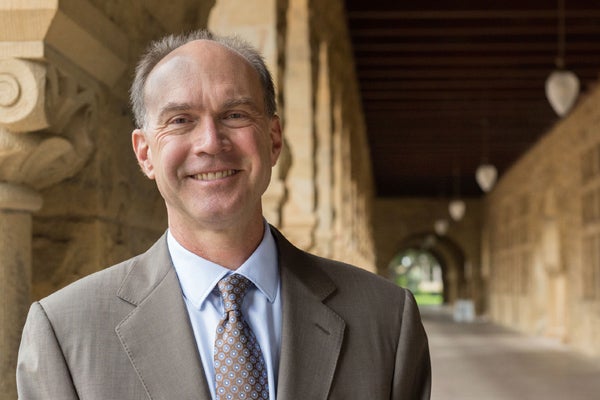|
May 19, 2014
Stanford Online courses from all parts of campus are reaching millions of learners globally
Stanford's online learning initiative is growing at a fast pace and the university is looking far beyond the MOOC at how to best educate students in the 21st century. A new report highlights accomplishments in 2013 and eyes the future of research-driven innovation. By Clifton B. Parker

John Mitchell heads the Office of the Vice Provost for Online Learning, which coordinates the university-wide Stanford Online initiative. (Photo: Judith Romero)
Online education is changing the way we learn, where we learn and how we think of higher education. Stanford Online is pioneering advances in teaching and learning at Stanford – and beyond – as its new report, "2013 in Review," describes.
The 32-page document reveals the explosive growth at Stanford Online – 1.9 million people from almost every country in the world have registered for one or more courses, and learners have spent more than 4 million hours engaging with Stanford Online courses since the fall of 2012.
Online courses and modules are taught by Stanford faculty and instructors and offered to Stanford students as part of "flipped" or "blended" campus classes; they are developed as massive open online courses (MOOCs) and offered to the public as free lifelong learning opportunities; and they are developed as professional education and continuing education courses for specialized and professional audiences.
Stanford Online is a university-wide initiative coordinated by the Office of the Vice Provost for Online Learning (VPOL), headed by Vice Provost John Mitchell. VPOL was created in 2012, and its mission is to advance the understanding and use of new technologies and teaching methods in support of Stanford students and faculty, in service to higher education and to promote lifelong learning.
Stanford has been associated with the advent of MOOCs, but its efforts to improve teaching and learning are much broader, the report underscored. Experiments in technology-driven and experiential education are occurring in every corner of the university and are strategically led by the vice provost's office. Some of the key questions being addressed include:
- How can the university help students learn more effectively?
- How can we better leverage classroom time?
- How can technology enable educators to better meet the needs of particular learners?
To answer these questions, faculty from all seven Stanford schools are now experimenting with creative uses of technology to improve course material. And the vice provost's office is building data-driven research capacity and coordinating with faculty and graduate students across campus in conducting research on technology-mediated instruction.
'Ecosystem' of knowledge
Stanford runs its own instance of an open-source online learning platform (Stanford OpenEdX) that supports research and experimentation in instructional design. VPOL engineers are contributing new features and code as part of a vibrant open-source community. And VPOL is committed to open collaboration on other fronts, contributing to an "open online ecosystem" by sharing course material and research with other education organizations.
Since the first three Stanford MOOCs were offered in fall 2011, VPOL has awarded 66 faculty seed grants to support faculty-driven initiatives, and has helped more than 145 faculty members from all seven schools produce 246 online offerings for campus or public use, delivered through three different online platforms (Stanford OpenEdX, Coursera and NovoEd).
"Stanford's vision is much broader than MOOCs," said Mitchell. "We're thinking about how we will best educate students for generations to come."
This involves moving the conversation away from "MOOC completion rates" to "engagement," or how learners are engaging with and benefiting from the material, the report noted. And at Stanford, the conversation is shifting from "technology-driven" to "research-driven" innovation in teaching and learning.
Billed as a "snapshot" of the research-driven approach at Stanford, the report describes demographics of Stanford Online users, gender enrollment survey data, time usage, countries and U.S. states with the highest rates of enrollment in free public online courses, collaboration with other universities, research possibilities and the "larger conversation" surrounding significant changes underway in higher education.
-30-
|